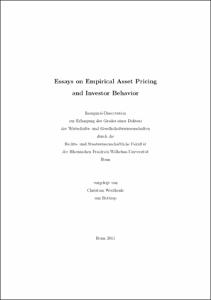Westheide, Christian: Essays on Empirical Asset Pricing and Investor Behavior. - Bonn, 2011. - Dissertation, Rheinische Friedrich-Wilhelms-Universität Bonn.
Online-Ausgabe in bonndoc: https://nbn-resolving.org/urn:nbn:de:hbz:5-24570
Online-Ausgabe in bonndoc: https://nbn-resolving.org/urn:nbn:de:hbz:5-24570
@phdthesis{handle:20.500.11811/4863,
urn: https://nbn-resolving.org/urn:nbn:de:hbz:5-24570,
author = {{Christian Westheide}},
title = {Essays on Empirical Asset Pricing and Investor Behavior},
school = {Rheinische Friedrich-Wilhelms-Universität Bonn},
year = 2011,
month = apr,
note = {The first chapter deals with an alternative asset pricing test. According to asset pricing theory, in expectation there is a positive reward for taking risks. However, using realized returns, this relation is frequently reversed. In order to take this into account, we apply a conditional approach to the predominant model in asset pricing, the Fama-French three-factor model. We find that all three risk factors cross-sectionally drive asset returns. While other papers stop their analysis at this point, we extend the test developed by Freeman and Guermat (2006) to multifactor models and test if risk premia are priced within the conditional approach. Our test leads to qualitatively identical results as the widely used Fama-MacBeth test and hence confirms its validity.
The second chapter considers implications from the predictive ability of investor sentiment concerning stock market returns over different time horizons. Recent empirical research suggests that measures of investor sentiment have predictive power for future stock returns over the intermediate and long term. Given the widespread publication of sentiment indicators, smart investors should trade on the information conveyed by such indicators and thus trigger an immediate market response to their publication. The present study is the first to empirically analyze whether an immediate response can be identified from the data. We use survey-based sentiment indicators from two countries (Germany and the US). Consistent with previous research we find there is predictability at intermediate time horizons. For the US, however, the predictability all but disappears after 1994. Using event study methodology we find that the publication of sentiment indicators affects market returns. The sign of the immediate response is the same as that of the predictability over the intermediate term. This finding is consistent with the idea that sentiment is related to mispricing, but is inconsistent with the idea that the sentiment indicator provides information about future expected returns.
The final chapter considers whether corporate insiders strategically time the trades in their own firm's stocks. It addresses the question of whether corporate insiders time their trades when asymmetric information between insiders and outsiders is high. Using data on corporate insider transactions in the U.S. between 1993 and 2008, we analyze the relationship between asymmetric information and the likelihood of insider trading. Our proxy for asymmetric
information is a firm’s idiosyncratic return volatility shortly prior to the point in time considered relative to its recent mean. Our findings indicate that this measure positively affects the likelihood of insider purchases,
which indicates that insiders buy shares when their informational advantage is high. However, the likelihood of an insider sale is, on average, not related to changes in asymmetric information.},
url = {https://hdl.handle.net/20.500.11811/4863}
}
urn: https://nbn-resolving.org/urn:nbn:de:hbz:5-24570,
author = {{Christian Westheide}},
title = {Essays on Empirical Asset Pricing and Investor Behavior},
school = {Rheinische Friedrich-Wilhelms-Universität Bonn},
year = 2011,
month = apr,
note = {The first chapter deals with an alternative asset pricing test. According to asset pricing theory, in expectation there is a positive reward for taking risks. However, using realized returns, this relation is frequently reversed. In order to take this into account, we apply a conditional approach to the predominant model in asset pricing, the Fama-French three-factor model. We find that all three risk factors cross-sectionally drive asset returns. While other papers stop their analysis at this point, we extend the test developed by Freeman and Guermat (2006) to multifactor models and test if risk premia are priced within the conditional approach. Our test leads to qualitatively identical results as the widely used Fama-MacBeth test and hence confirms its validity.
The second chapter considers implications from the predictive ability of investor sentiment concerning stock market returns over different time horizons. Recent empirical research suggests that measures of investor sentiment have predictive power for future stock returns over the intermediate and long term. Given the widespread publication of sentiment indicators, smart investors should trade on the information conveyed by such indicators and thus trigger an immediate market response to their publication. The present study is the first to empirically analyze whether an immediate response can be identified from the data. We use survey-based sentiment indicators from two countries (Germany and the US). Consistent with previous research we find there is predictability at intermediate time horizons. For the US, however, the predictability all but disappears after 1994. Using event study methodology we find that the publication of sentiment indicators affects market returns. The sign of the immediate response is the same as that of the predictability over the intermediate term. This finding is consistent with the idea that sentiment is related to mispricing, but is inconsistent with the idea that the sentiment indicator provides information about future expected returns.
The final chapter considers whether corporate insiders strategically time the trades in their own firm's stocks. It addresses the question of whether corporate insiders time their trades when asymmetric information between insiders and outsiders is high. Using data on corporate insider transactions in the U.S. between 1993 and 2008, we analyze the relationship between asymmetric information and the likelihood of insider trading. Our proxy for asymmetric
information is a firm’s idiosyncratic return volatility shortly prior to the point in time considered relative to its recent mean. Our findings indicate that this measure positively affects the likelihood of insider purchases,
which indicates that insiders buy shares when their informational advantage is high. However, the likelihood of an insider sale is, on average, not related to changes in asymmetric information.},
url = {https://hdl.handle.net/20.500.11811/4863}
}






